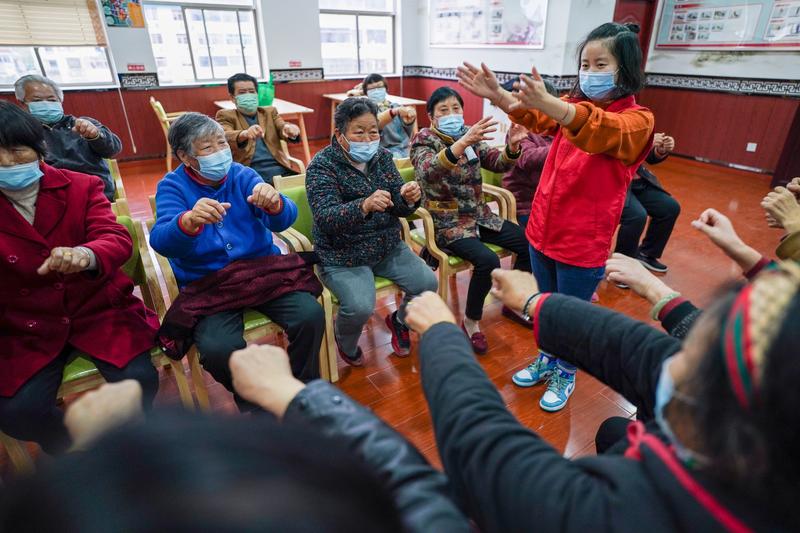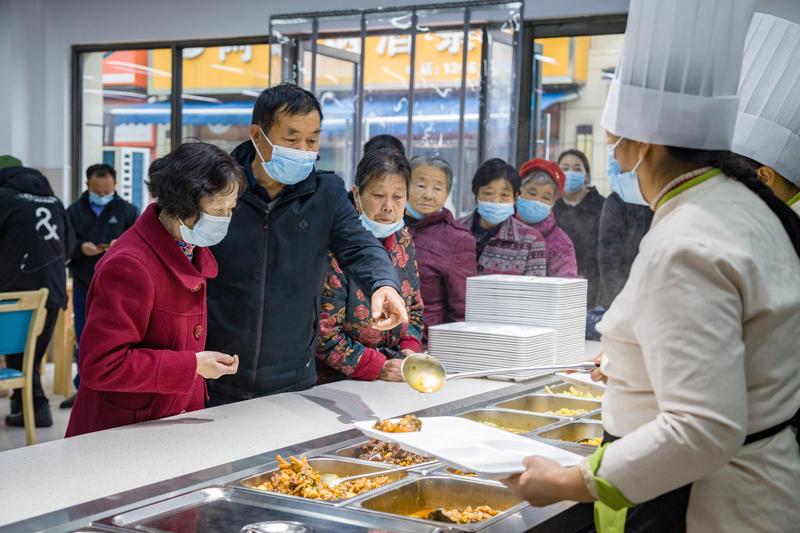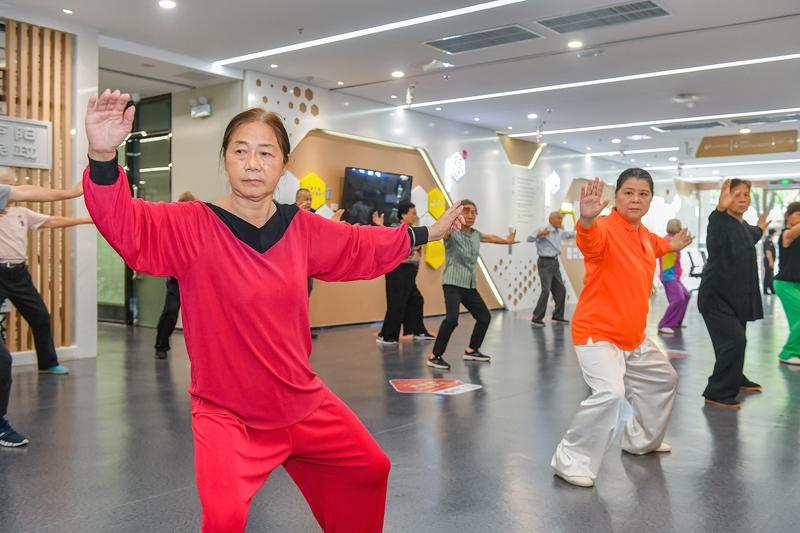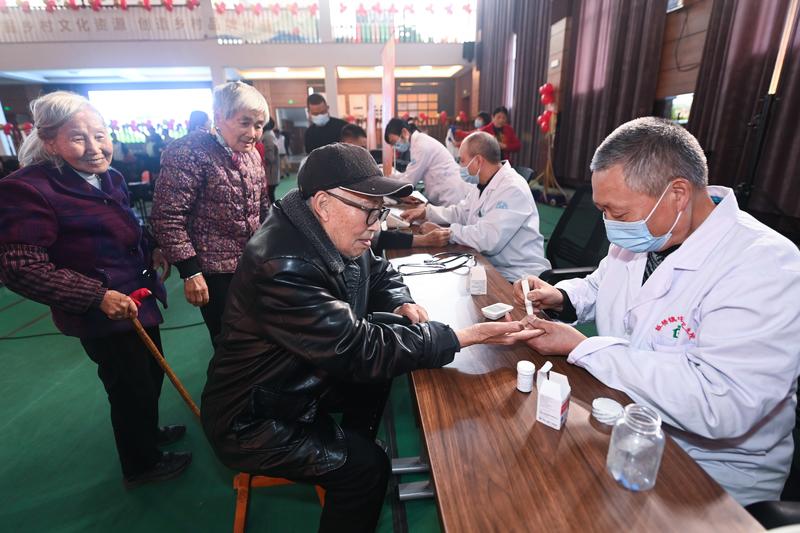Moves may include the gradual raising of the national retirement age and changes to the ways senior care is funded. Li Lei reports.
 Volunteers give a senior a haircut in Tengzhou, Shandong province, in October. (LI ZHIJUN / XINHUA)
Volunteers give a senior a haircut in Tengzhou, Shandong province, in October. (LI ZHIJUN / XINHUA)
As officials wrapped up 12 months of work and planned for the future at closely watched meetings that marked the end of the year, issues involving older people came under the spotlight.
Data published by the National Health Commission in October showed that 267 million people, or 18.9 percent of the population, were age 60 and older.
That meant every 100 working-age Chinese was supporting 20.8 pensioners age 65 and older, double the number a decade ago. The increased burden was noted by officials who met last month for the annual Central Economic Work Conference, where China's economic policies for the coming year were decided.
The participants decided to "safely" advance the building of a national unified pension fund system this year and raise the retirement age gradually and at "an appropriate time" as part of broader efforts to strengthen the social safety net.
 Seniors do finger exercises with staff members at an elderly care center in Yancheng, Jiangsu province, in November. (LI BO / XINHUA)
Seniors do finger exercises with staff members at an elderly care center in Yancheng, Jiangsu province, in November. (LI BO / XINHUA)
Unified pension
In February last year, the Ministry of Human Resources and Social Security announced that the country had finished building a unified pension fund, which was originally started in the 1990s and had been operated by local authorities at different levels.
The segmented pension fund has had problems balancing the budgets in less-developed inland regions due to a shortage of contributors and growing numbers of retirees. That's because large numbers of younger people migrate to wealthier coastal provinces, lured by better salaries, and contribute to the fund in their new locality.
Ministry of Finance data show that the fund's deficit topped 130 billion yuan ($18.6 billion) last year in the northeastern Rust Belt provinces of Liaoning, Jilin and Heilongjiang, forcing the central government to cover the shortfall.
However, with no such concerns, wealthier locations lacked incentives to raise the rate workers pay. That may prove problematic in the long run in light of China's rapidly aging population.
Speaking at a news conference in February last year, Qi Tao, who oversees the fund at the ministry, said it has been unified on a national scale, making it possible to transfer money across regions and assist struggling provinces, but central and local government payment duties still needed to be worked out in the years to come.
"Central government support for local authorities will not decrease, though," he said.
 Customers order food at a community restaurant for seniors in Hefei, Anhui province, in November. (RUAN XUEFENG / XINHUA)
Customers order food at a community restaurant for seniors in Hefei, Anhui province, in November. (RUAN XUEFENG / XINHUA)
Allowing contributors to work for longer would also relieve the pressure, but while policymakers have deliberated raising the retirement age for years, the policy has still not been fully implemented.
In a proposal unveiled in November 2020, the Communist Party of China Central Committee said authorities will raise the retirement age in a "progressive manner", but failed to provide details.
Retirement ages in China — 60 for men and 55 for women — are significantly lower than in Japan, Germany and many other aging countries. Moreover, people in labor-intensive jobs or those with occupational diseases and work-induced disabilities are allowed to retire up to 10 years earlier.
Proponents of prolonging career duration, such as Lin Bao, a researcher at the Chinese Academy of Social Sciences, argued that the move would be a sensible reform given that future retirees will spend more time at school than older people, and reform would help improve the pension fund's resilience. Opponents including Chen Lixiang, vice-chairman of the Chinese Society for Technical and Vocational Education, feared the adjustment could result in mass youth unemployment.
Last month, Cai Fang, a senior legislator, told a forum that individuals should be protected and supported by society. Also, China's pledge to achieve common prosperity means that older people must join the middle-income group. However, historical reasons mean that "many older workers in our time are less educated or are inadequately trained, which makes gradual reform necessary", he said.
 People practice tai chi at a seniors' service center in Hefei, in September. (YUAN BING / FOR CHINA DAILY)
People practice tai chi at a seniors' service center in Hefei, in September. (YUAN BING / FOR CHINA DAILY)
Consumption driver
Older people, especially richer urban retirees, are increasingly seen by policymakers as potential consumers to drive economic growth. This was outlined in measures designed to raise domestic consumption between now and 2035.
The measures, issued by the CPC Central Committee and the State Council, China's Cabinet, were released on Dec 14 via the Xinhua News Agency. In a section focused on expanding the service sector, the lengthy document urged local authorities to regard senior care work as both a government task and an emerging industry.
Authorities were asked to accelerate efforts to build a senior care system with nursing homes and home-based support as the twin pillars, and a healthcare system that combines medical and nursing functions.
The Ministry of Civil Affairs said the number of beds at retirement homes nationally reached 8.12 million in the first quarter of last year, up from 3.81 million in 2012, but the per capita number was still lower than in developed countries.
In September, Li Yongxin, who oversees senior care issues at the ministry, told a news conference that the task of developing "multilayered and diverse" services for older people was "crucial and pressing". He noted that the number of disabled, "empty-nest" seniors who live alone was rising, creating compelling demand for long-term care.
According to the National Health Commission, China had about 40 million disabled or semidisabled seniors with mobility issues in 2021. Meanwhile, data from Meituan, a catering app that hosts many service providers, show that searches for services to help older people bathe or shower jumped eightfold year-on-year in 2021.
To rectify the nursing home shortfall and provide better care for those with health issues, authorities have worked to mobilize communities, businesses and medical institutions to contribute their share. Hospitals have been encouraged to provide nursing beds or offer door-to-door services and virtual appointments for older patients recovering at home.
Retirement homes have also been urged to engage medical entities to build wards for sick residents so they don't have to shuttle between hospitals and long-term care facilities.
An estimate by the Fudan Institute on Aging, an affiliate of Fudan University in Shanghai, suggested that China's gray economy could surpass $19.11 trillion by 2035 and hit $49.87 trillion by the middle of the century. In the same period, spending on senior care as part of total consumption is projected to rise from 27 percent to 35 percent.
In an interview with Securities Daily, Pan Helin, a researcher with Zhejiang University, said the sector's expansion was made possible by several factors such as the growing acceptance of senior care services and the higher spending power of Chinese people, who for generations have depended on families for assistance in old age.
 Medical volunteers provide free health checks for seniors at a village in Hangzhou, Zhejiang province, in November. (XU YU / XINHUA)
Medical volunteers provide free health checks for seniors at a village in Hangzhou, Zhejiang province, in November. (XU YU / XINHUA)
COVID-19 control
Those attending the Central Economic Work Conference said a key task this year will be to help older people and those with preexisting conditions stay safe and avoid critical symptoms amid the spread of COVID-19. The livelihoods of older people and other vulnerable groups must be safeguarded against outbreak-induced disruptions, they added.
Older Chinese were among the groups hit worst by Omicron-fueled outbreaks last month.
Data from the Guangdong Second Provincial Hospital in South China showed that 80 percent of the hospitalizations at its respiratory and critical care departments were people age 60 and older.
Meanwhile, the China-Japan Friendship Hospital and Chaoyang Hospital, both in Beijing, reported that the majority of their COVID hospitalizations were older people with underlying health conditions.
That's because seniors have lagged behind in getting vaccinated as a result of concerns over adverse reactions.
Official data show that about 239.4 million, or 90.6 percent, of people age 60 and older had received at least one shot by Nov 28. About 228.1 million, or 86.4 percent, had received two shots, but only 181.5 million had received a booster shot by the same date.
The numbers of those age 80 and older who had received one shot, two shots and booster shots were still lower, at 76.6 percent, 65.8 percent and 40 percent, respectively.
The shortfall prompted the NHC to accelerate vaccinations of older people in recent weeks. The commission's data show that 3.1 million doses were administered on Dec 20, with 3.6 million given the following day, up from the daily average of less than 1.5 million in the previous two weeks.
As Spring Festival approaches, many migrants are expected to return to their rural hometowns from cities where the number of COVID cases has been rising over the past month. That poses a risk to rural residents, many of whom are seniors.
The annual central rural work conference was held in Beijing on Dec 23 and 24. Xi Jinping, general secretary of the CPC Central Committee, who is also China's president and chairman of the Central Military Commission, attended the meeting and delivered an important speech.
He said the target of "ensuring basic modern living conditions in the rural areas" means development projects must be well-organized and implemented to speed up the construction of public service facilities in fields such as anti-epidemic programs, senior care, education and healthcare.
Officials attending a Dec 24 meeting on COVID-19 control in the rural regions described the countryside as "vast, populous and thinly resourced". They said the upcoming mass migration would pose a new COVID-19 challenge in rural areas.
Local authorities were urged to quickly vaccinate senior rural residents and members of other vulnerable groups, and to ensure that outbreaks don't disrupt the supply of agricultural materials, such as fertilizer.
County hospitals serve a large number of people from nearby villages and townships, mostly older folk whose children work in large cities.
Over the past month, related institutions nationwide, from the Inner Mongolia autonomous region to Fujian and Hebei provinces, have raced to purchase life-support equipment as part of wider efforts to bolster the supply of critical-care facilities.
Contact the writer at lilei@chinadaily.com.cn


